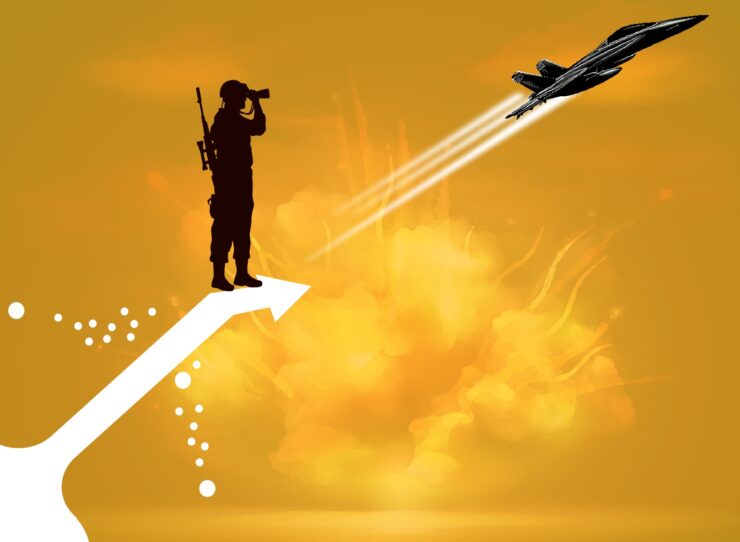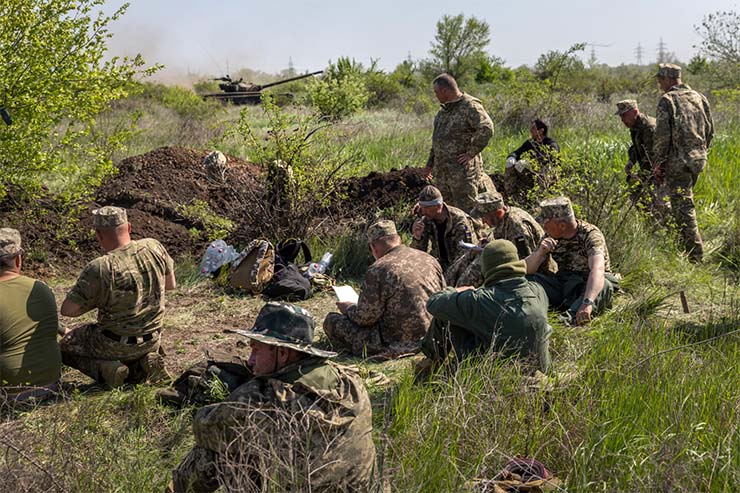
Indian economic growth applies to sectors across the board, and that is a fact. But careful allocation of R&D efforts, acquisition policies and industrial development must make the best of whatever public monies are made available to fuel the economy and its future. As budgets become more generous, pegged on economic growth, temptation can arise to acquire high-tech gadgetry, peddled by industrialists to justify costs, and which will hardly benefit the purchasing country if they are not integrated into a complementing and mutual vision aligned with desired operational effects.
With this in mind, and with no pretense towards comprehensive perspectives, here are three takeaways:
3-Dimensional Warfare, Down to the Smallest Echelons
This phenomenon started during the 2020 Nagorno-Karabakh conflict between Armenia and Azerbaijan and became full-fledged in Ukraine shortly thereafter. These new theatres of operation are characterised by thousands of simultaneously flying aerial vehicles, with very few of them manned. Ukraine is showing the world that drones have now completely penetrated the battlefield, down to combat units, companies and platoons, and are no longer considered bulky, precious assets that armies used to take out for special occasions.
Their missions have also broadened considerably, now ranging from surveillance to combat. But their most decisive added value is their ability to cut through the fog of war: strikes can now get decisively accurate whether on the front lines (such as trench defense) or attack; offensive drones can complement indirect fire with micro-strikes or help improve the accuracy of indirect weapons such as mortars and artillery. These tactical choices can be made on-site and in real time, by the company or platoon commanders.
Naturally, counter-drone technology has followed a parallel development, as electronic warfare’s capacity to jam enemy drone communication would now provide a great advantage to battlefield management or just simply level out the playing field in the face of this cheap, intrusive and ubiquitous threat.
The Return of the Updated Classics
The Ukrainian conflict is still confined to roughly less than one quarter of its territory, but its nature closely resembles the parameters of conventional large-scale warfare, the last such bloody conflict Europe saw was in World War 2. The tactical zeitgeist of the past 20 years, favoring the permanent quest for tactical superiority through surgical strikes by ever-smaller and-nimbler units, seems to have disappeared in favor of girth, mass and firepower. Unlike what Western armies have known over the past 30 years, this deadly conflict pits two full-fledged armies, and not some expeditionary corps, and can be considered as an asymmetrical confrontation.
Given the adversary at hand, Ukraine and its allies have reverted to the greater tautologies of classic warfare: fire kills; and bigger is better. This applies also, and even much more, to the Russian side, with the seemingly endless accumulation of brute, raw, firepower. Older equipment is maintained and modernized, and no longer being phased out in favor of more modern weaponry: if it can shoot, it can kill, even if the technology is 50 years old. Equipment as ancient as water-cooled Maxim machine guns and T-54 or T-55 tanks (between 75 and 100 years old) have been seen deployed and used by both sides.
Mass is also making a big comeback, as it is an essential ingredient of frontline and in-depth resistance. Given Russian numbers, no strategy is worthwhile if it isn’t backed by corresponding pairs of boots on the ground, not to mention the ever-important reserve forces necessary to manoeuvers that require yet additional mass. Firepower and mass are also a way to address attrition rates. This concept is also making a great comeback, and needs to be replenished, giving manpower recruitment and industrial production capacity (as autonomous, if not independent, as possible) more importance than ever.
The predating strategy of “centralized design and decentralized execution”, in which an overview of the desired effect is ensured by the central command but freedom of initiative is left to ground-level commanders to reach the said objectives, is also returning, after the Russians showed lack thereof in the earlier offensives. A certain type of asymmetry may be seen in the near future, time will tell: it seems the Ukrainians are using this approach at the tactical level, with high flexibility, while the Russians keep this art for the operational level.
The heart of the firepower mass is made of standing combined arms grouping (whatever their levels, company, battalion, brigade…). Armour, armoured infantry, self-propelled artillery, combat engineering, in integrated interaction with one another, and in proportion to the environment in which they are deployed – the specific mix of expertise is not the same in urban or forested areas, as it is in open fields. The rise in the combined use of these platforms, which is not quite new, is accompanied by development efforts to enable their resistance to the devastating strikes we are seeing: rooftop strike protection (namely against loitering munitions), enhanced situational awareness, and self-defence systems.
Finally, the combined impact of mass engagement and “industrial attrition” is causing a surge of sales, from manufacturers who are called upon to reinforce and replenish capabilities for Western armies. Panzer-producing Germany has not missed the opportunity as both manufacturers are offering new models: the KF51 Panzer from Rheinmetall and the Leopard 2 A8 from KMW. Poland is beefing up its forces and, following new orders, namely from Korean suppliers, it is set to become one of the largest armies in the world, nearing the United States.
Renewed Mobilization of Ideology and Morale Management
Morale management seems to be the object of particular concern on both sides – a likely consequence of the return of high intensity warfare in Europe and Asia. Casualty counts are suspiciously diverging, as both sides try to minimise the damage taken during operations, in an attempt to counteract despair from the population whose resolve will be called upon in the foreseeable future. Both sides, Ukrainian and Russian, are fighting in difficult conditions: harsh leadership, low comfort and sometimes obsolete equipment for the conscripts on both sides, and size-and-power imbalance for the Ukrainians. Russia’s narrative seems to be that nothing will defeat the Eastern might, while Ukraine highlights each small individual victory.
Simultaneously, disinformation and character assassination are being fuelled like seldom before: the enemy is evil, God is with us, and victory is inevitable – ironically on both sides. This propaganda goes far beyond the theatre of operation: Ukraine vitally needs the moral commitments of its international allies, as also to keep up the recruiting in the Foreign Legion; whereas the furthered non-alignment of regional powers is benefitting Russia. This effort aims to preserve the support of public opinion in favor of the operation’s political objectives, as the onset was not as efficient as had been hoped for.
Finally, technology is not only helping with tactics, but also with communication. Footage collected on the battlefield with GoPro cameras is used to fuel morale – when the contents are advantageous – or used as evidence for accusations of war crimes – plentiful on both sides. This footage is oftentimes completed with content obtained from reconnaissance drones, or through more classic channels of intelligence. Social media is also being used massively to disseminate the footage, with more or less positive results. War viewership, which started in 1990 with Operation Desert Storm, has now trickled down to the individual level, with the foot soldier acting as war reporter and his entourage distributing the footage. The systematic use of positive and negative emotions is a powerful PR weapon used to influence public opinion, both among friend and foe.
Fact-checking is suspiciously selective, on both sides of the frontline. Agencies such as Oryx and Bellingcat issue news bulletins that are taken at face value by the mainstream media, with the same lack of critical thinking and perspective as those with which Russian outlets handle official communications. News agencies seem content with the seemingly independent bulletins and conveniently overlook the fact that their sources are from the West, which is politically and morally heavily invested in the conflict. Unsurprisingly, popular opinion is also.
The Ukrainian conflict resembles older episodes of high-intensity warfare as much as it differs from them. At the operational and tactical levels, the ongoing conflict brings us back to the fundamentals of industrial warfare, amended and updated with a few modern developments, more than it really changes the art of warfare – aside from drones turning conflicts into absolute three-dimensional spaces, all the way down to the lowest echelons or even to the individual level. The main change induced by this conflict will be political and strategic, more than military, and may well amount to a turning point in modern history. But that’s another story, for another day.
Reference
- high-tech gadgetry
- https://irgc.org/wp-content/uploads/2018/12/Kott-for-IRGC-Resilience-Guide-Vol-2-2018.pdf
- drones
- Drones over Ukraine: What the war means for the future of remotely piloted aircraft in combat (theconversation.com)
- girth, mass and firepower
- Russia’s army: An overestimated power – DW – 09/29/2022
- high intensity warfare
- https://www.lemonde.fr/en/international/article/2023/02/24/after-one-year-of-war-in-ukraine-allied-armies-forced-to-adapt-to-russian-reality_6017126_4.html
– The writer is a defence and security industry consultant having varied experience working with medium and large companies majorly in European market. The views expressed are personal and do not necessarily reflect the views of Raksha Anirveda









